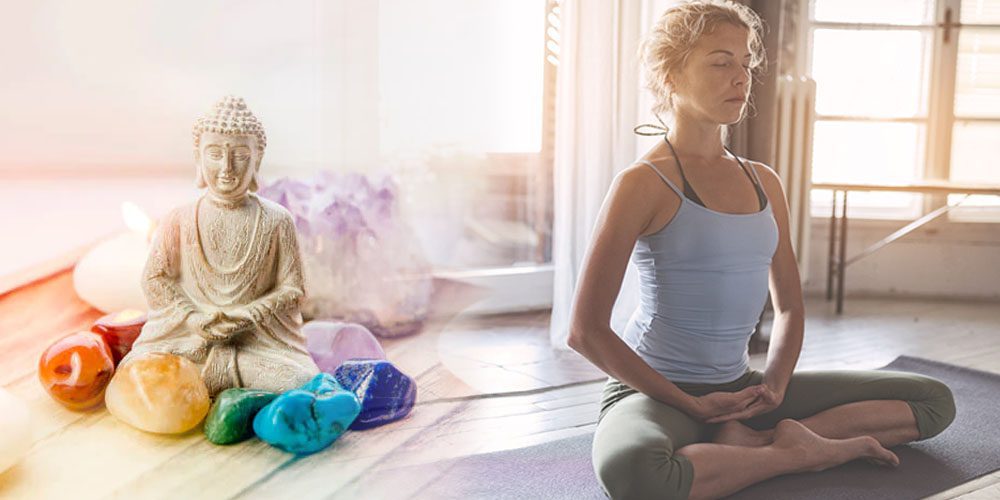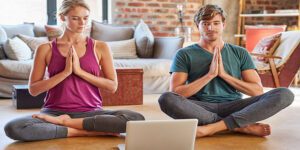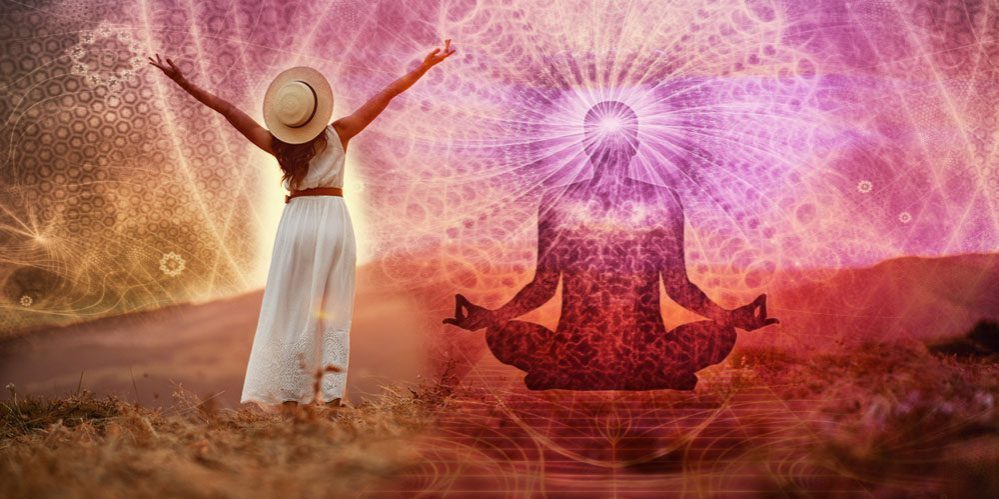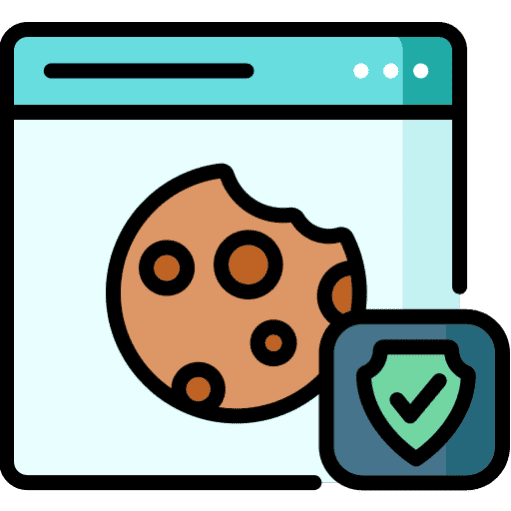In a world where chaos and commotion seem to be the norm, there is one sanctuary that remains steadfast: our inner self. For centuries, humans have sought solace in the silence of their minds, tapping into the deep reservoirs of wisdom and tranquility that lay hidden beneath the surface.
The art of meditation has served as the compass guiding countless individuals toward the oasis of inner peace. But what if I told you that, while you may have tasted the sweet nectar of mindfulness, there is an entire world of meditation tools just waiting to take your practice to new heights?
Picture this: you're seated comfortably, your spine aligned, and your breath steady. As you gently close your eyes, the familiar hum of silence envelops you, beckoning you to dive deeper into the vast ocean of consciousness. But, just as you're about to surrender to the depths, a gentle melody, like the song of a distant bird, floats through the air, infusing your meditation with an ethereal quality that transports you to a realm beyond time and space.
In this land of serenity, you are cradled by the earth, the rich scent of incense swirling around you, grounding your spirit while your body is supported by a cushion designed to foster perfect posture. A symphony of sensations, from the gentle vibrations of singing bowls to the smooth surface of meditation beads, accompanies you on this journey, each one a stepping stone to discovering the true nature of your inner world.
Welcome, my fellow seeker, to “Beyond Silence: Exploring the World of Meditation Tools.” In the chapters that follow, we will traverse the vast and varied landscape of meditation tools, from the humble cushion to the ancient singing bowls, delving into the stories, the science, and the spirituality that imbues these instruments with the power to transform our lives. No matter if you're a seasoned practitioner or a curious newcomer, this guide will illuminate the path to deeper understanding and a more profound connection with the self.
As we embark on this journey together, we will not only explore the tools themselves but also the ways in which they can be incorporated into your practice to enhance its potency. Whether you're looking to deepen your focus, elevate your spirit, or simply create a more immersive and enjoyable experience, you'll find the key to unlocking new dimensions of mindfulness within these pages.
Moreover, this expedition will not be a one-size-fits-all endeavor; we recognize that each individual's journey is unique, and our aim is to provide you with a treasure trove of meditation tools, each with its own special qualities and benefits so that you can find the perfect fit for your own personal practice.
Allow yourself to be swept away by the enchanting tales of how these tools have shaped the lives of practitioners across time and cultures, while simultaneously exploring the scientific research that supports their efficacy. Together, we will transcend the boundaries of the ordinary and venture into a realm where the harmonious marriage of ancient wisdom and modern insight paves the way for a richer, more fulfilling meditation experience.
So, dear reader, I invite you to join me on this odyssey into the world of meditation tools. Together, we will peel back the veil of the ordinary, daring to venture into the extraordinary realms that lie just beyond the silence. As we explore this vast expanse, may we find solace, wisdom, and connection, and may our meditation practices be forever transformed.
Are you ready to embark on this adventure? If so, take a deep breath, steady your mind, and let us begin our journey beyond silence.
The Basics of Meditation and its Benefits
Meditation is a practice that has been around for centuries, and it involves training one's mind to focus and achieve a state of relaxation. It is often used to reduce stress, anxiety, depression, and other mental health conditions.
Regular meditation practice can improve overall well-being by promoting physical health benefits such as lower blood pressure, improved immune function, better sleep quality, and reduced pain. During meditation practice, individuals typically sit or lie down in a quiet place free from distractions.
They focus their attention on their breath or another point of concentration to calm their mind and achieve mental clarity. This can be a challenging task for beginners who may struggle with racing thoughts or restlessness during the process.
The Benefits of Using Tools for Meditation Practice
While the practice of meditation can be rewarding on its own, using tools can significantly enhance the experience by providing support and comfort during sessions. There are many different types of meditation tools available that cater to different needs and preferences.
One significant benefit of using tools is that they provide physical comfort during sessions. Sitting on a cushion or mat helps elevate the hips above the knees for optimal spinal alignment while sitting cross-legged.
This reduces pressure on the lower back muscles enabling longer meditative sits without discomfort. Another benefit is that some tools enhance sensory experiences during meditation sessions which foster relaxation more easily than without them.
For example, lighting candles or burning incense can engage our senses which calms us down quickly because we associate them with feelings of calmness from past experiences. Some people may find it difficult to focus solely on their breath; playing gentle background music or listening to guided meditations could serve as an excellent alternative in keeping them focused throughout their session.
Why Use Niche Meditation Tools?
While some tools are commonplace, others are considered “niche” and are less commonly used. These tools can be an excellent way to enhance the meditative experience further.
Singing bowls are an example of a niche tool that can provide auditory stimulation and promote relaxation. When hit with a mallet, they produce harmonic frequencies that calm the mind and relax the body.
Yantra paintings or mandalas offer visual stimulation during meditation sessions. These geometric patterns and symbols function as focal points in which practitioners can concentrate their attention on, promoting visual relaxation.
Crystals or gemstones have been used for centuries as aids for spiritual practices because they are believed to have healing properties. They serve as physical reminders of one's intention for their practice while also providing a grounding energy during the process.
The Advanced Tools for Deep Meditation
For advanced practitioners who want to take their meditation practice to another level, there are more advanced tools available that utilize technology such as biofeedback machines, float tanks, and brainwave entrainment devices. The use of biofeedback machines allows individuals to monitor their physiological responses such as heart rate variability or breathing patterns during meditation practice. With this knowledge, one can train themselves to control these responses better, achieving deeper states of relaxation and focus.
For sensory deprivation lovers who want a truly immersive experience with minimal stimulus input, Float tanks do just that by simulating zero gravity environments using saltwater-filled tanks. This allows an individual's mind to relax even more profoundly since it is freed from external stimuli like sound or light which reduces stress hormones levels significantly giving them instant calmness feeling after each session
Brainwave entrainment devices help synchronize brainwaves according to desired states of consciousness using sound waves at specific frequencies. This helps individuals achieve mental clarity and focus much faster than without any technological assistance
Choosing the Right Meditation Tool(s)
It's essential to choose tools that align with your needs and goals for practicing meditation. Some may prefer a more sensory-focused experience, while others may value physical comfort or deeper states of consciousness. When deciding which tools to use, it's important to do research and experiment with different options.
Don't be afraid to try new things when trying to find what works best for you. Meditation is a practice that requires patience and curiosity, so don't be discouraged if not everything works the first time around.
Using tools during meditation practice can significantly enhance the overall experience by providing physical comfort, sensory stimulation, or technological assistance in achieving deeper states of relaxation and focus. It's essential to choose the right tools based on your individual preferences and goals for practicing meditation.
Common Meditation Tools
When it comes to meditation, comfort is key. Sitting in the same position for an extended period of time can be challenging, especially if you are not used to it. This is where meditation cushions and mats come in handy.
Cushions and Mats for Comfort During Seated Meditation
They are designed to provide support and comfort during seated meditation, so you can focus on your practice without any discomfort. Meditation cushions come in different shapes and sizes to suit different body types and preferences.
The most common type is the zafu cushion, which is round and stuffed with buckwheat hulls or kapok fibers. It elevates your hips and tilts your pelvis forward to help maintain a comfortable upright posture.
Zabuton mats are also popular among meditators. They are rectangular-shaped mats that provide a cushioned surface for your knees, ankles, and feet during seated positions such as cross-legged or kneeling postures.
Incense, Candles, or Essential Oils for Sensory Stimulation
The sense of smell can have a powerful impact on our emotions and mood. That's why many people use incense, candles, or essential oils during meditation practice to create a calm atmosphere that promotes relaxation.
Incense comes in various scents such as sandalwood, lavender, frankincense, or jasmine. Burning incense not only adds fragrance but also creates smoke that symbolizes the transience of life – a reminder of impermanence often taught in Buddhist philosophy.
Meditation Candles add visual appeal as well as soothing scents like lavender or bergamot that help reduce stress levels during meditation practice. Essential oils can also be diffused using an aromatherapy device for inhalation purposes providing similar calming effects as incense and candles but with more control over scent intensity.
Music or Guided Meditations for Focus
Meditation can be challenging when your mind is wandering, and you can't seem to focus. That's where music and guided meditations come in handy. They provide a point of focus that helps anchor the mind, reduce distractions, and create a sense of tranquility.
Music can range from instrumental tracks with calming sounds like ocean waves or bird songs to more traditional Indian or Tibetan chants that are believed to have spiritual significance. Guided meditations are pre-recorded audio tracks that guide you through different aspects of meditation such as body scans, breathing techniques, or visualization exercises.
Mala Beads for Counting Breaths or Mantras
Mala beads are strings of 108 beads traditionally used in Hindu and Buddhist cultures during meditation practice. They are used as a tool for counting breaths or repeating mantras – phrases repeated throughout meditation as a way of focusing the mind and calming emotions. The mala is held in the right hand, draped over the middle finger with the thumb used to move between each bead after every repetition.
The index finger isn't used because it represents ego according to some belief systems. Mala beads come in various materials such as sandalwood, rosewood, or gemstones like amethyst or aventurine each believed to hold its own spiritual significance promoting relaxation and inner peace during mediation practice.
Endeffekt
There are many tools available to enhance your meditation practice – cushions & mats for comfort during seated meditation; incense/ candles/essential oils for sensory stimulation; music/guided meditations for focus; mala beads for counting breaths/mantras. Experiment with different tools until you find what works best for you.
Advanced Meditation Tools
Now that we have gone through the basics of meditation it’s time to look at some advanced tools.
Singing Bowls: Sound Therapy for Deep Relaxation
If you're looking to deepen your meditation practice through sound therapy, singing bowls are a must-have tool. These beautiful instruments produce a vibrational frequency that can help entrain your brain waves into a calm, meditative state.
As you focus on the sound of the bowl, your mind begins to let go of distracting thoughts and become more present. Some people even use singing bowls for chakra healing or to release emotional blockages.
When selecting a singing bowl, pay attention to the material and size of the bowl. The material can affect the sound quality and resonance.
Traditional bowls are made from seven metals, including gold and silver, but you can also find crystal singing bowls or those made from other materials like bronze. The size of the bowl can also impact its sound quality; larger bowls tend to have a deeper tone than smaller ones.
Yantra Paintings or Mandalas: Visual Focus for Mindfulness
If you're a visual person, using yantra paintings or mandalas during meditation can be an effective way to stay focused and present. Yantras are geometric designs used in Hindu and Buddhist traditions as tools for meditation and spiritual practice. They often incorporate multiple shapes and symbols that represent different aspects of consciousness.
Mandalas are similar in function but take on a circular form with intricate patterns that radiate outwards from the center point. Coloring mandalas has become a popular form of meditation in recent years because it allows you to focus on something tangible while still maintaining mindfulness.
When choosing yantras or mandalas for your practice, consider the colors and patterns that resonate with you most deeply. Some people prefer more intricate designs while others find simplicity more calming.
Crystals or Gemstones: Energy Healing Through Earthly Elements
Crystals and gemstones have long been used for their healing properties, and they can also be effective tools for meditation. Each crystal has a unique energetic vibration that can help balance and align your chakras or promote overall well-being.
Some popular crystals for meditation include amethyst, which is known for its calming effects, and rose quartz, which promotes self-love and compassion. Holding a crystal in your hand during meditation or placing it on a specific chakra point can amplify its energetic properties.
When choosing crystals or gemstones for your practice, consider the intention behind your meditation and select stones that align with that intention. You may also want to research the different properties of each crystal to find the ones that resonate most with you.
Aromatherapy Diffusers: Calming Scents for Relaxation
Aromatherapy can be a powerful tool for relaxation and stress relief during meditation. Using an aromatherapy diffuser allows you to fill your space with calming scents like lavender or chamomile while you meditate, promoting deeper relaxation and focus.
When selecting an aromatherapy diffuser, consider the size of your space as well as the type of essential oils you want to use. Some diffusers require water or heat while others use ultrasonic technology to disperse oils into the air without any added moisture.
Experiment with different essential oil blends to find what works best for you during meditation. Some people prefer single oils like frankincense or sandalwood while others enjoy more complex blends designed specifically for relaxation or spiritual practice.
Expert Meditation Tools
If you still want a deeper or more scientific experience, we will go into some Expert Meditation Tools in this section.
Brainwave Entrainment Devices: Synchronizing Mind and Body
Meditation is all about achieving a state of harmony between the mind and body. Brainwave entrainment devices help achieve this by synchronizing brainwaves with desired states of consciousness.
These devices use audio or visual stimuli to guide brain activity into specific frequencies, such as alpha, theta, or delta waves. This can enhance focus, relaxation, or creativity during meditation.
One popular type of brainwave entrainment device is called a binaural beats headset. This device plays two different sounds at slightly different frequencies in each ear, which creates a third tone that the brain perceives as a beat.
The frequency of this beat corresponds to a specific brainwave state, which can help achieve the desired mental state for meditation. Another type of brainwave entrainment device is called a light and sound machine.
These machines use pulsing lights and sounds to activate specific regions of the brain related to relaxation or focus. They often come with pre-programmed sessions tailored for specific meditation goals.
Float Tanks: Depriving Your Senses for Deep Relaxation
If you're looking for an immersive meditation experience that takes you beyond everyday consciousness, float tanks may be just what you need. Float tanks are also known as sensory deprivation chambers because they eliminate external sensory input such as sight and sound.
A float tank typically contains about 10 inches of water mixed with Epsom salt to create buoyancy that allows you to float effortlessly on your back without any effort required from your muscles. The water temperature matches your body's surface temperature so that over time you lose all sense of where your body ends and the water begins creating an experience free from gravity.
This lack of external stimulation allows your mind to enter deeper states of relaxation and meditation where it's easier to access subconscious thoughts and feelings. Many people describe feeling a sense of weightlessness or even an out-of-body experience when using float tanks.
Biofeedback Machines: Connecting Mind and Body
Biofeedback machines provide real-time feedback on physiological responses, such as heart rate, muscle tension, or brain activity. This information can help you become more aware of how your body responds to stress and how to control it.
During meditation, biofeedback machines can help you monitor your progress by showing you visual representations of various bodily functions that are involved in the meditation process such as breathing rate or heart rate variability. Another useful feature of biofeedback machines is the ability to set goals for specific physiological responses and track progress over time.
This way, you can measure the effectiveness of different meditation techniques and see which ones work best for you. In addition to improving meditation practice, biofeedback machines can also be used outside of meditation to improve overall health and well-being by controlling stress levels.
Abschluss
Advanced meditation tools offer a unique way to enhance your practice beyond traditional methods like sitting quietly with your eyes closed. With brainwave entrainment devices, float tanks, and biofeedback machines, it's easier than ever to achieve deeper states of relaxation and focus during meditation while increasing personal awareness about the mind-body connection. By experimenting with different tools available in the market today – especially those that are less conventional – we open ourselves up to new possibilities for growth within our practice as well as within ourselves overall.
Tips on Choosing the Right Meditation Tool(s)
Ok, now you might be overwhelmed with ideas about what tools to use for your meditation practice. Here are some tips on how to choose the right tool for you.
Consider Personal Preferences and Needs
When it comes to choosing the right meditation tool, it's important to consider your personal preferences and needs. For example, if you enjoy visual stimulation, you may want to try using yantra paintings or mandalas during your meditation practice. On the other hand, if you have difficulty staying focused, a guided meditation or music may be more helpful for you.
Additionally, consider any physical limitations or discomforts that may arise during seated meditation. If you experience back pain or discomfort in your knees, investing in a cushion or mat can help alleviate those issues.
Take some time to reflect on what would make your meditation practice more comfortable and enjoyable for you. This will help guide your decision-making process when it comes to selecting the right tools.
Research the Effectiveness of Different Tools
There are countless meditation tools available on the market today. From singing bowls to biofeedback machines, it can be overwhelming trying to navigate all of the options.
Before investing in any particular tool, take some time to research its effectiveness. Look for scientific studies or reviews from other meditators who have used the tool before.
This will help give you an idea of whether or not the tool is worth investing in. It's also important to note that not every tool works for every individual.
What works well for one person may not work as well for another. Keep this in mind as you do your research and consider how others' experiences with a particular tool align with your own needs and preferences.
Experiment with Different Options to Find What Works Best
Ultimately, finding the right meditation tool(s) requires some experimentation on your part. Try out different options and take note of how they impact your practice.
Start by incorporating one new tool at a time into your routine. For example, if you're interested in using mala beads, start by using them during one or two meditation sessions per week.
This will allow you to see how they impact your practice without overwhelming yourself with too many changes at once. As you experiment with different tools, pay attention to how they make you feel during and after meditation.
Do they help you stay focused? Do they lead to deeper states of relaxation?
Do they improve your overall experience? By taking the time to experiment and reflect on your experiences, you'll be better able to identify which tools work best for you and how they can enhance your meditation practice.
The Importance of Flexibility
It's important to remember that our needs and preferences can change over time. A tool that worked well for us in the past may no longer be effective or enjoyable. As such, it's important to remain flexible and open-minded when it comes to incorporating new tools into our meditation practice.
Don't be afraid to try new things or revisit old tools that didn't work as well for you in the past. By remaining flexible and open-minded, we allow ourselves the opportunity to grow and evolve alongside our meditation practice.
When in Doubt, Keep it Simple
It's worth noting that sometimes the most effective “tool” for meditation is simplicity itself. While there is certainly value in using various props and aids throughout one's practice, sometimes all we really need is a quiet space and a few moments of focused attention. If all else fails or if you find yourself overwhelmed by the sheer number of options available, don't hesitate to simplify your approach.
Strip away any unnecessary distractions or external stimuli and focus solely on your breath or a simple mantra. Remember: at its core, meditation is about cultivating mindfulness and inner peace – two things that require nothing more than our own presence and attention.
Letzte Worte
Using meditation tools can significantly enhance your practice and take it to new heights. The wide variety of tools available, from cushions and mats to advanced biofeedback machines, makes it easy to find something that resonates with you and supports your individual needs.
Incorporating meditation tools into your practice can help you achieve greater levels of relaxation, focus, and insight. Cushions and mats provide comfort during seated meditation, allowing you to sit for longer periods without discomfort or distraction.
Incense, candles, or essential oils can enhance sensory stimulation and create a calming atmosphere conducive to deep relaxation. Music or guided meditations are great options for those who struggle with focus or have busy minds.
These tools provide a focal point that helps the mind let go of distractions and enter a deeper state of relaxation. Mala beads are also helpful for those who need physical aid in counting breaths or mantras.
Advanced meditation tools like singing bowls, yantra paintings, crystals or aromatherapy diffusers offer unique benefits that may resonate with certain individuals more than others. Sound therapy with singing bowls is great for restoring balance within the body-mind system; Yantra paintings or mandalas provide visual focus; Crystals support energy healing; Aromatherapy diffusers help calm the senses.
Expert meditation tools such as brainwave entrainment devices and float tanks offer even deeper levels of relaxation by synchronizing brainwaves with desired states of consciousness or providing sensory deprivation for introspection. Biofeedback machines allow individuals to monitor physiological responses and improve their mind-body connection through real-time feedback.
Whatever tool(s) you choose to incorporate into your practice, remember that they are only aids in helping you reach deeper states of awareness. You still have the power within yourself to achieve the benefits of meditation without any external aids whatsoever – but using these tools will certainly make it easier!
So next time you sit down to meditate, consider trying out a new tool and see how it enhances your practice. The possibilities are endless.

















